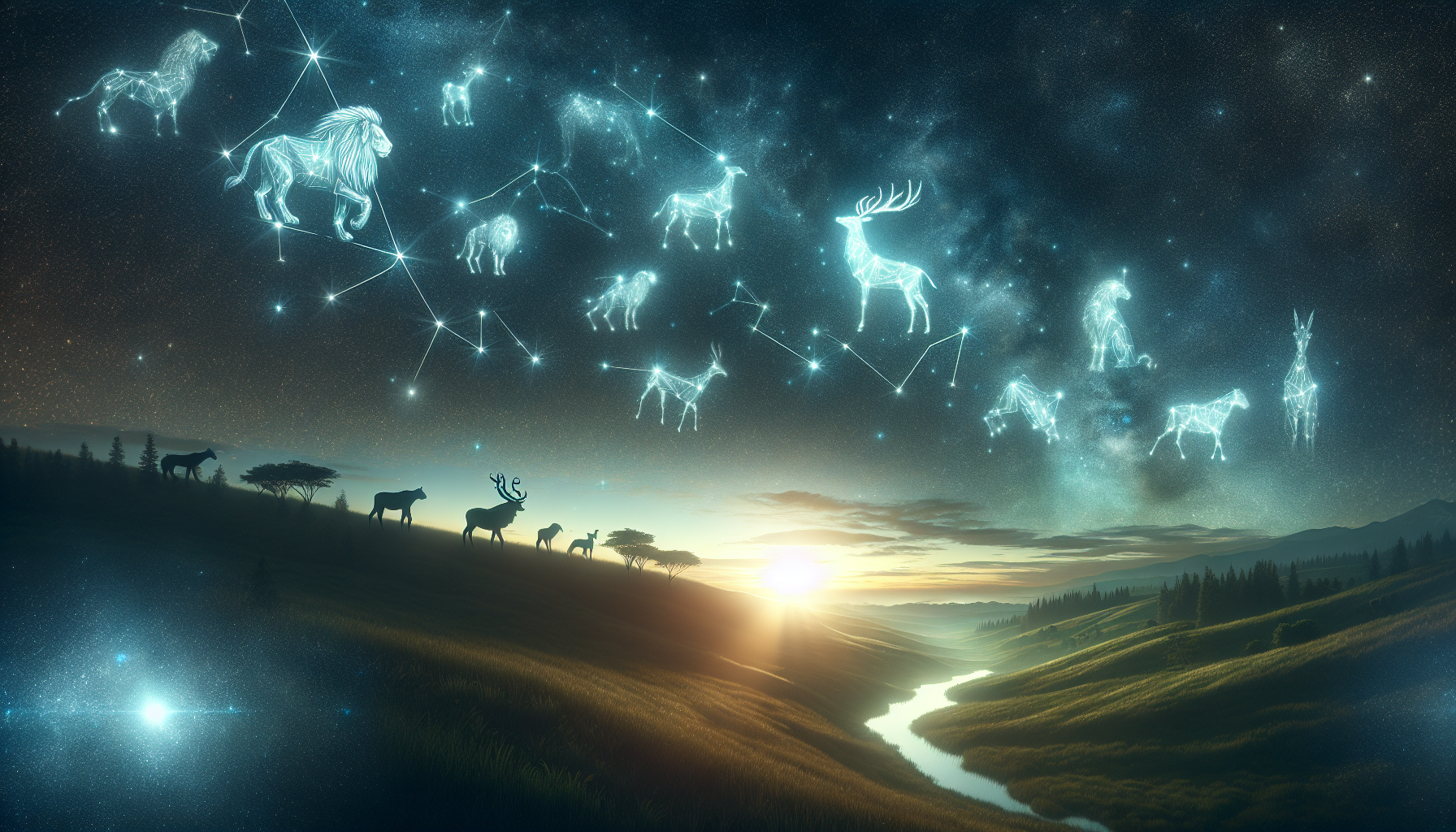In the vast tapestry of the night sky, stars have always held a special place in the human imagination. They have been our navigators, our storytellers, and our companions in the silent watches of the night. But what if these celestial patterns, these constellations, could tell a story that resonates not just with the past, but with the whimsical wonders of the animal kingdom? Welcome to the enchanting world of “Unleashing the Wild: Exploring Constellation Diagrams with Fabulous Animals,” where the cosmos meets the animal realm in a dance of creativity and exploration. 🌌
For centuries, different cultures have gazed upon the stars, drawing lines between them to form images of gods, heroes, and creatures that danced across the heavens. Each constellation holds a narrative, a piece of cultural heritage passed down through generations. But as we peer deeper into these starry patterns, a new realm of possibilities unfolds—one where the stars align to create not just mythological beings, but also the majestic and often fantastical creatures of the animal kingdom. Imagine a lion not just as Leo, the noble guardian of the zodiac, but as a mighty guardian of celestial secrets. Consider the swan not just as Cygnus, but as a symbol of grace and transformation as it soars through the night sky.
This article invites you to embark on a journey where constellations transform into a menagerie of fabulous animals, each with its own unique story and symbolism. We’ll delve into the origins of traditional constellations, exploring how ancient civilizations mapped the stars and assigned them significance. From there, we’ll venture into the realm of creativity, imagining how these stellar arrangements could represent the diverse and wondrous creatures that roam our planet. Whether it’s a playful dolphin swimming through a sea of stars or a wise owl perched among the celestial branches of a cosmic tree, the possibilities are as boundless as the universe itself.
Moreover, we’ll explore the cultural significance of animals in constellations across various societies. How did different civilizations interpret the presence of animals in the sky? What do these interpretations tell us about their beliefs, values, and relationship with nature? By examining the intersection of astronomy, mythology, and zoology, we’ll uncover the deeper meanings behind these celestial creatures and how they reflect the human experience across time and space. This exploration will not only broaden our understanding of constellations but also highlight the enduring connection between humanity and the natural world. 🦁🌠
Finally, we’ll consider the modern implications of reimagining constellations with animals. In an age where technology allows us to explore the universe like never before, how can we use these new interpretations to foster a greater appreciation for both the cosmos and the biodiversity of our planet? Through the lens of education, art, and conservation, we’ll discuss how these fabulous animal constellations can inspire a new generation of stargazers to see the universe—and our place within it—in a whole new light. Whether you’re an astronomy enthusiast, an animal lover, or simply someone with a curious mind, this journey promises to be a stellar adventure that connects us to the wild wonders above and below. 🌍✨
Understanding Constellation Diagrams
Constellation diagrams are pivotal in visualizing the modulation of signals in telecommunications. They provide a graphical representation of how signal modulation translates data into waveforms, which are then transmitted through various media. Essentially, a constellation diagram maps out the possible symbols that can be transmitted, each represented by a point in a two-dimensional plane. The axes of the diagram are typically the in-phase component (I) and the quadrature component (Q) of the signal.
These diagrams are instrumental in analyzing the quality of signal transmission, as they allow engineers to observe deviations and distortions that may occur during transmission. For instance, when noise affects a signal, the points in a constellation diagram will scatter around their ideal positions, providing a visual cue of the signal integrity. By studying these variations, engineers can identify and rectify issues in the communication system.
Moreover, constellation diagrams are used to distinguish between different modulation schemes, such as Quadrature Amplitude Modulation (QAM) and Phase Shift Keying (PSK). Each modulation scheme has a unique pattern on the constellation diagram, allowing for easy identification and analysis. As such, constellation diagrams are a critical tool in both academic studies and practical applications of telecommunications.
The Role of Fabulous Animals in Constellation Exploration
Bringing the realm of constellation diagrams to life, the metaphor of fabulous animals provides an engaging way to understand these complex visualizations. Just as each point in a constellation diagram represents a possible signal, each animal in a constellation can symbolize an aspect of the story or message being conveyed. This metaphorical approach helps demystify the technical nature of the diagrams, making them more accessible to a wider audience.
In mythology and storytelling, animals often embody various attributes and characteristics that resonate with human emotions and experiences. Similarly, in constellation diagrams, each symbol embodies specific data points that together create a cohesive narrative about the signal’s behavior. By equating these diagrams to mythical creatures, we can explore the intricate dance of signals as a vivid tapestry of interactions, akin to a story unfolding in the sky.
Comparative Analysis of Modulation Schemes
To further delve into the world of constellation diagrams, it’s important to compare different modulation schemes and their respective diagrams. Below is a table that highlights the differences between several popular modulation techniques, including their complexity, signal capacity, and common uses.
| Modulation Scheme | Constellation Pattern | Complexity | Signal Capacity | Common Uses |
|---|---|---|---|---|
| QPSK | 4 points in a square | Moderate | Moderate | Satellite communications |
| 16-QAM | 16 points in a grid | High | High | Broadband internet |
| BPSK | 2 points on a line | Low | Low | Deep space communication |
As you can see, each modulation scheme has its own unique constellation pattern, which correlates with its complexity and capacity. The choice of modulation depends largely on the application and the required balance between complexity and performance. In satellite communications, for example, QPSK is preferred due to its balance of simplicity and efficiency, whereas 16-QAM is favored in broadband applications for its high data rate capabilities.
Each modulation technique brings its own set of challenges and benefits, making the understanding of constellation diagrams all the more crucial in optimizing signal transmission. By comparing these schemes, one gains a deeper insight into the intricate balance of factors that engineers must consider in the design and deployment of communication systems.
Exploring Further Resources
To dive deeper into the fascinating world of constellation diagrams and their applications, consider exploring additional resources. There are numerous online tutorials and videos that can further elucidate the concepts discussed. One recommended video is “Understanding Constellation Diagrams” by the IEEE Channel, which provides a comprehensive overview of the topic. Watching such videos can enhance your understanding and offer practical insights into real-world applications.
Additionally, participating in online forums and communities dedicated to telecommunications can provide valuable opportunities to engage with experts and enthusiasts alike. These platforms often feature discussions, Q&A sessions, and shared resources that can significantly bolster your knowledge and expertise in the field.
Whether you’re a student, professional, or hobbyist, there is a wealth of information available to help you master the art of constellation diagrams. By taking advantage of these resources, you can deepen your understanding and appreciation of this fascinating aspect of telecommunications.
Check out this engaging video on the topic: Understanding Constellation Diagrams from IEEE Channel.

Conclusion
**Conclusion: Embracing the Wilderness of Constellation Diagrams through Fabulous Animals**
As we journeyed through the captivating world of constellation diagrams with fabulous animals, we uncovered the intricate tapestry that intertwines mythology, astronomy, and the wild imagination of human culture. These celestial patterns not only serve as a guide to the stars but also echo the stories and beliefs of ancient civilizations, demonstrating how humanity has long sought to find meaning in the vastness of the night sky.
One of the key points we explored is the historical significance of constellations and their role in navigation and timekeeping. Early astronomers, by mapping the stars and creating stories around them, provided a way for seafarers and travelers to find their way across uncharted territories. The legacy of these constellations, such as Leo, the majestic lion, and Aquila, the soaring eagle, continues to inspire awe and wonder.
Moreover, we delved into the cultural richness these constellations bring to different societies. From the Aboriginal Australians to the ancient Greeks, each culture has its unique interpretation and mythology associated with the stars. These narratives not only enrich our understanding of diverse cultural heritages but also highlight a shared human curiosity about the universe and our place within it.
The scientific aspect of constellation diagrams was also a focal point. We discussed how modern astronomy uses these ancient patterns to locate stars and galaxies, demonstrating how tradition and science can coexist harmoniously. By exploring the technological advancements in telescopes and star-mapping software, we acknowledged the role of constellations as a bridge between past and present.
Furthermore, we touched on the emotional and psychological impact of these celestial creatures. The symbolism of animals in constellations often reflects our inner desires, fears, and aspirations. The mighty Orion, for instance, represents strength and adventure, while Cygnus, the swan, embodies grace and beauty. These symbols continue to resonate with us, providing a sense of connection to something greater than ourselves.
In contemplating these themes, we recognize the importance of maintaining our celestial heritage. The stories of these fabulous animals in the sky remind us of the power of imagination and the endless possibilities that lie beyond our immediate perception. By encouraging a deeper appreciation for constellations, we foster a sense of wonder and curiosity that is essential for both personal growth and scientific advancement.
As we conclude our exploration, we invite you to further engage with the constellations and their stories. Whether through stargazing, joining an astronomy club, or simply reading more about these celestial wonders, there are countless ways to deepen your connection to the stars. Consider sharing your experiences and insights with others, as collective knowledge and curiosity can lead to even greater discoveries.
We also encourage you to reflect on the symbolic meanings of these constellations in your life. How do these celestial patterns inspire you? What stories do they evoke within you? By pondering these questions, you can uncover new dimensions of understanding and perhaps even find guidance in your own journey.
In this era of technological advancement, where light pollution threatens our view of the night sky, it’s more important than ever to advocate for the preservation of our dark skies. Supporting initiatives and organizations that work towards reducing light pollution can help ensure that future generations will have the opportunity to gaze upon the same stars that have guided and inspired humanity for millennia.
As you embark on your own celestial adventures, remember the power of the stories we tell about the stars. These narratives, passed down through generations, remind us of our shared human experience and the infinite possibilities that await us. By embracing the wilderness of constellation diagrams and the fabulous animals within them, we not only honor our past but also inspire future explorations of the cosmos.
In closing, we hope this exploration of constellation diagrams has enriched your understanding and appreciation of the stars above. We invite you to comment, share your thoughts, and engage with others who share your curiosity about the universe. Together, we can continue to explore the mysteries of the cosmos and unleash the wild within our imaginations. 🌌
**References and Further Reading:**
2. International Dark-Sky Association
3. European Space Agency’s Star Mapping
Toni Santos is a visual storyteller and archival illustrator whose work revives the elegance and precision of scientific illustrations from the past. Through a thoughtful and historically sensitive lens, Toni brings renewed life to the intricate drawings that once shaped our understanding of the natural world — from anatomical diagrams to botanical engravings and celestial charts.
Rooted in a deep respect for classical methods of observation and documentation, his creative journey explores the crossroads of art and science. Each line, texture, and composition Toni creates or curates serves not only as a tribute to knowledge, but also as a meditation on how beauty and truth once coexisted on the page.
With a background in handcrafted artistry and visual research, Toni merges historical accuracy with aesthetic reverence. His work draws inspiration from forgotten sketchbooks, museum archives, and the quiet genius of early illustrators whose hands translated curiosity into form. These visual relics — once found in dusty volumes and explorer journals — are reframed through Toni’s practice as enduring symbols of wonder and intellect.
As the creative force behind Vizovex, Toni curates collections, essays, and artistic studies that invite others to rediscover the visual languages of early science. His work is not just about images — it’s about the legacy of observation, and the stories hidden in ink, parchment, and pigment.
His work is a tribute to:
The discipline and artistry of early scientific illustrators
The forgotten aesthetics of exploration and discovery
The quiet beauty of documenting the natural world by hand
Whether you’re a lover of antique diagrams, a natural history enthusiast, or someone drawn to the timeless union of science and art, Toni welcomes you into a world where knowledge was drawn, not digitized — one plate, one specimen, one masterpiece at a time.




